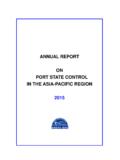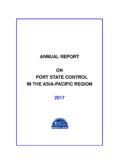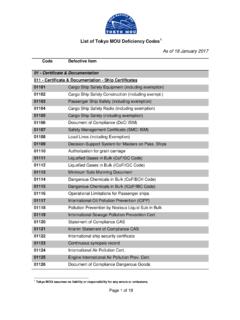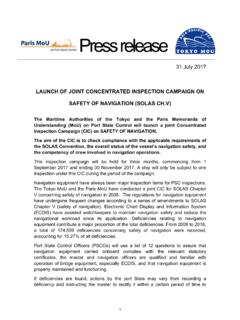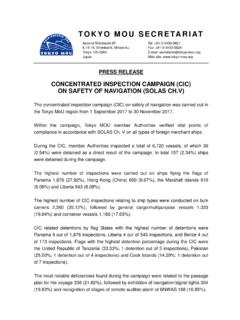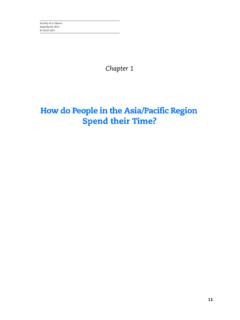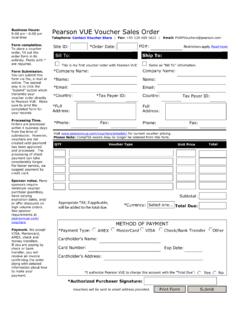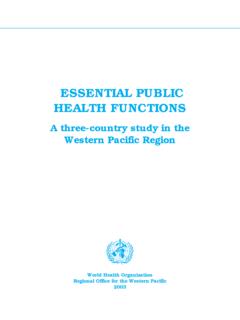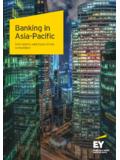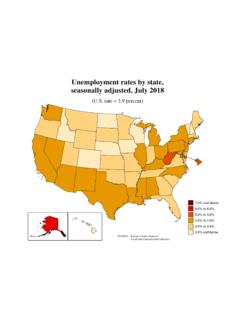Transcription of ANNUAL REPORT ON PORT STATE CONTROL IN THE ASIA- …
1 ANNUAL REPORT ON PORT STATE CONTROL IN THE ASIA- pacific REGION 2016 This work is copyright. It may be reproduced in whole or part subject to the inclusion of an acknowledgement of the source but not for commercial use or sale. Further information may be obtained from: The Tokyo MOU Secretariat Ascend Shimbashi 8F 6-19-19 Shimbashi Minato-ku, Tokyo Japan 105-0004 Tel: +81-3-3433-0621 Fax: +81-3-3433-0624 This REPORT is also available at Tokyo MOU web-site ( ) on the Internet. MEMORANDUM OF UNDERSTANDING ON PORT STATE CONTROL IN THE ASIA- pacific REGION FOREWORD We are pleased to present the ANNUAL REPORT on Port STATE CONTROL in the ASIA- pacific Region 2016. Since the introduction of the new inspection regime in 2014 in the Tokyo MOU, the number of deficiencies, number of detentions, detention percentage and number of individual under-performing ships have all decreased, whilst the number of inspections has increased slightly.
2 From these facts we can conclude there has been an improvement in both the quality and performance of ships operating in the region attributed to successful and effective operation of the Tokyo MOU. These positive and encouraging outputs result from the great efforts of the member Authorities of the Tokyo MOU for continuous enhancement and improvement of port STATE inspections. This ANNUAL REPORT outlines the port STATE CONTROL developments and activities of the Tokyo MOU that took place in 2016. In addition, the REPORT also provides port STATE CONTROL statistics and analysis on the results of inspections carried out by member Authorities during the year. Although there has been a general trend of improvement in the quality and performance of shipping in the region, there are still unsafe and substandard ships trading around the region.
3 The Tokyo MOU is firmly determined to continue its endeavours to improve and harmonize PSC activities towards the aim of eradication of substandard ships in the region. Carlos Fanta Hideo Kubota Chairman Secretary Port STATE CONTROL Committee To k y o MOU Secretariat MEMORANDUM OF UNDERSTANDING ON PORT STATE CONTROL IN THE ASIA- pacific REGION CONTENTS page OVERVIEW General introduction .. 1 Review of year 2016 .. 2 The Port STATE CONTROL Committee .. 3 Technical Working Group (TWG) .. 5 The Third Joint Ministerial Conference .. 6 The ASIA- pacific Computerized Information System (APCIS) .. 6 Training and seminars for port STATE CONTROL officers .. 6 Co-operation with other regional port STATE CONTROL agreements .. 9 PORT STATE CONTROL UNDER THE TOKYO MOU, 2016 Inspections .. 12 Detentions .. 12 Deficiencies .. 13 Overview of port STATE CONTROL results 2006-2016.
4 14 ANNEX 1 -- STATUS OF THE RELEVANT INSTRUMENTS .. 21 ANNEX 2 -- PORT STATE INSPECTION STATISTICS .. 24 Statistics for 2016 .. 24 Summary of port STATE inspection data 2014-2016 .. 34 ANNEX 3 -- ORGANIZATION STRUCTURE OF THE TOKYO MOU .. 54 Explanatory Note on the Black-Grey-White Lists .. 55 MEMORANDUM OF UNDERSTANDING ON PORT STATE CONTROL IN THE ASIA- pacific REGION LIST OF FIGURES AND TABLES page Figure 1 Inspection percentage .. 15 Figure 2 Inspection per ship risk profile .. 15 Figure 3 Port STATE inspections - contribution by Authorities .. 16 Figure 4 Type of ship inspected .. 16 Figure 5 Detentions per flag .. 17 Figure 6 Detention per ship type .. 17 Figure 7 Deficiencies by main categories .. 18 Figure 8 Most frequent detainable deficiencies .. 18 Figure 9 No. of inspections .. 19 Figure 10 Inspection percentage .. 19 Figure 11 No. of inspections with deficiencies .. 19 Figure 12 No.
5 Of deficiencies .. 20 Figure 13 No. of detentions .. 20 Figure 14 Detention percentage .. 20 Figure 15 Comparison of inspections per ship type .. 40 Figure 16 Comparison of detentions per ship type .. 40 Figure 17 Comparison of inspections with deficiencies per ship type .. 42 Figure 18 Comparison of number of deficiencies by main categories .. 48 Figure 19 Comparison of most frequent detainable deficiencies .. 50 Table 1 Status of the relevant instruments .. 21 Table 1a Status of MARPOL 73/78 .. 23 Table 2 Port STATE inspections carried out by Authorities .. 24 Table 2a Port STATE inspections on maritime security .. 25 Table 3 Port STATE inspections per ship risk profile .. 26 Table 4 Port STATE inspections per flag .. 27 Table 5 Port STATE inspections per ship type .. 30 Table 6 Port STATE inspections per recognized organization .. 31 Table 7 Deficiencies by categories .. 33 Table 8 Black Grey White Lists.
6 35 Table 9 Inspections and detentions per flag .. 36 Table 10 Inspections and detentions per ship type .. 41 Table 11 Inspections with deficiencies per ship type .. 43 Table 12 Inspections and detentions per recognized organization .. 44 Table 13 Performance of recognized organization .. 46 Table 14 Comparison of deficiencies by categories .. 49 Table 15 Comparison of most frequent detainable deficiencies .. 51 Table 16 List of under-performing ships .. 52 MEMORANDUM OF UNDERSTANDING ON PORT STATE CONTROL IN THE ASIA- pacific REGION 1 OVERVIEW GENERAL INTRODUCTION The ANNUAL REPORT on Port STATE CONTROL in the ASIA- pacific Region is published under the auspices of the Port STATE CONTROL Committee of the Memorandum of Understanding on Port STATE CONTROL in the ASIA- pacific Region (Tokyo MOU). This ANNUAL REPORT is the twenty-second issue and covers port STATE CONTROL activities and developments in the 2016 calendar year.
7 The Memorandum was formed in Tokyo on 1 December 1993 and came into effect on 1 April 1994. In accordance with the provisions of the Memorandum, Authorities that have signed and formally accepted the Memorandum or that have been accepted by unanimous consent of the Port STATE CONTROL Committee become full members. Currently, the Memorandum has 20 full members, namely: Australia, Canada, Chile, China, Fiji, Hong Kong (China), Indonesia, Japan, Republic of Korea, Malaysia, the Republic of the Marshall Islands, New Zealand, Papua New Guinea, Peru, the Philippines, the Russian Federation, Singapore, Thailand, Vanuatu and Viet Nam. A maritime Authority that has declared its intention to fully adhere to the Memorandum within a three-year period may be accepted as a co-operating member by unanimous consent of the Port STATE CONTROL Committee.
8 Panama is currently participating in the Tokyo MOU as a co-operating member Authority. The main objectives of the Memorandum are to establish an effective port STATE CONTROL regime in the ASIA- pacific region through co-operation of its members, harmonization of the members activities, to eliminate sub-standard shipping, to promote maritime safety and security, to protect the marine environment and to safeguard seafarers working and living conditions on board ships. The Port STATE CONTROL Committee established under the Memorandum monitors and controls the implementation and on-going operation of the Memorandum. The Committee consists of representatives from the member Authorities, co-operating member Authorities and observers. Observer status has been granted to the following maritime Authorities and inter-governmental organizations by the Committee: Democratic People s Republic of Korea, Macao (China), Samoa, Solomon Islands, Tonga, United states Coast Guard, the International Maritime Organization (IMO), the International Labour Organization (ILO), the Paris MOU, the Vi a del Mar Agreement, the Indian Ocean MOU, the Black Sea MOU and the Riyadh MOU.
9 The Secretariat of the Memorandum is located in Tokyo, Japan. For the purpose of the Memorandum, the following instruments are the basis for port STATE CONTROL activities in the region: the International Convention on Load MEMORANDUM OF UNDERSTANDING ON PORT STATE CONTROL IN THE ASIA- pacific REGION 2 Lines, 1966; the Protocol of 1988 relating to the International Convention on Load Lines, 1966, as amended; the International Convention for the Safety of Life at Sea, 1974, as amended; the Protocol of 1978 relating to the International Convention for the Safety of Life at Sea, 1974; the Protocol of 1988 relating to the International Convention for the Safety of Life at Sea, 1974; the International Convention for the Prevention of Pollution from Ships 1973, as modified by the Protocol of 1978 relating thereto, as amended.
10 The International Convention on Standards for Training, Certification and Watchkeeping for Seafarers, 1978, as amended; the Convention on the International Regulations for Preventing Collisions at Sea, 1972; the International Convention on Tonnage Measurement of Ships, 1969; the Merchant Shipping (Minimum Standards) Convention, 1976 (ILO Convention No. 147); the Maritime Labour Convention, 2006; the International Convention on the CONTROL of Harmful Anti-fouling Systems on Ships, 2001; and the Protocol of 1992 to amend the International Convention on Civil Liability for Oil Pollution Damage, 1969. REVIEW OF YEAR 2016 The Tokyo MOU conducted a concentrated inspection campaign (CIC) on Cargo Securing Arrangements from 1 September to 30 November 2016.
